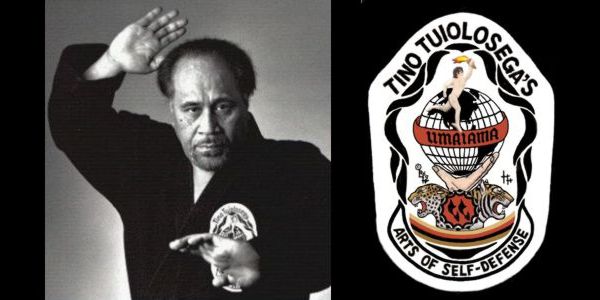Limalama is an American Polynesian art of self-defense, created and founded by Tu’umamao “Tino” Tuiolosega.
The word LIMALAMA means “The Hand of Wisdom”. It is derived from two Polynesian words – “Lima” and “Malamalama”. “Lima”is a popular term in both the Samoan and Hawaiian languages and it means “five”or “hand” and the term “Malamalama” is defined in the Samoan language as “understanding”, “bright”, “brilliant” or “intelligent”. Using both words in their entirety would create a word difficult to pronounce, so the word “Lima” was joined to “Lama” from “Malamalama” to create the word LIMALAMA.
The intention of the Founder, Tu’umamao “Tino” Tuiolosega was to create a word that expressed and projected understanding in a non-biased mood. He wanted the word to convey the message of warm feeling, and the sense of humility.
Roots of the System
When Limalama was developed, the following thirteen Samoan movements were utilized as a basic foundation.
- Afikau – the study of warrior’s traditions, specifically dance.
- Amofoe – the understanding of the manipulation of weights, shifting and swaying tactics to off balance weight.
- Fa’aelise – the study of coordination, reflexes, balance, holds, breaks and throws.
- Fa’ako’elau – movements similar to wrestling, including holds and tripping.
- Faufusu or Ku’iku’iga – movements similar to hand to hand fighting, boxing or street fighting.
- Lua’aga or Le’iga – the study of pressure points, nerves and joints.
- Milosia – the study of the execution, delivery and application of circular movements; such as locking wrists.
- Pepelu ma Pega – the study of knife fighting, this is a cutting coordination. This is a conceptual method in the use of weaponry.
- Uma Ma Kaupi’I – the study of holds, breaks and take downs.
- Vaeka ma Kavae – the study of foot movements such as kicks and foot counter movements.
- Ti’apega ma Lo’u – the study of Kaoi’a, stick fighting.
- Tal’amoa – the study of combining several of the other concepts together.
- Upaga ma Lo’ulo’uga – the study of trapping.
He formalized these movements and combined them with his extensive background of boxing and street fighting and created a contemporary, and comprehensive self defense system that others could understand and practice. The cause and affect patterns of these motions and movements are learned through the application of: a) Limalama forms, b) Limalama techniques, c) controlled reflexes, d) physical balance, and e) mental awareness, alertness and stability. It also inspires confidence in one’s own abilities.
Limalama has been modified and revised throughout the years to cope with a changing society. It is influenced by a definite American motivation for realistic concepts in self-defense with an emphasis on mental acuity and physical ability. However, Limalama remains oriented toward its Polynesian origins.
Limalama Creed
I pledge the principles of Limalama with honor and dignity to God, my fellowmen and Country, with faith in the common decency of man to respect one another, to accept each other with valued distinctions of honesty and truthfulness and to be considerate of each other’s inalienable rights with unbiased awareness.
Limalama, the Hand of Wisdom, is the persistent acceptance of progress with an open mind to better understanding, and the ensuing encouragement of mans’ insistence upon significant developments of his mind and body to further improve and ensure sound health, confidence, love, wisdom and wholeness.
Limalama, The Hand of Wisdom, is dedicated to God, with the belief in the preservation of human rights, human dignity and the pursuit of happiness, with liberty and justice for all mankind, regardless of religion, race, color or creed, toward the betterment of today’s success encouraging tomorrow’s progress.
I uphold these beliefs to be self-evident, to preserve the sacred life, family, God and my Country.
“Imua Limalama”
Philosophy of LimaLama
The Philosophy of Limalama, like the Art itself, the Limalama Coat of Arms Patch was designed to serve not only practitioners, but also the public at large. We believe this Patch is unique in its ability to declare the ideal principles of the Limalama Arts of Self Defense in a pictographic form. It identifies Limalama to the world, and its symbols teach the doctrine and philosophy of the Limalama Arts of Self-Defense. Those symbols remind practitioners, students and instructors of our obligations and responsibilities to ourselves, our family, our fellow man, and our country, and our respect for law and order. In it Limalama is represented as we believe it to be: a God-given endowment or blessing for its membership, for the common good of all people throughout the world. The following is a brief explanation of the various symbols that comprise the Limalama Coat of Arms or Patch. Hopefully, this will assist students in understanding more fully the philosophy behind the Art. The components in the Limalama Patch each represent specific ideals and philosophies of the Limalama Arts of Self-Defense.
Frame of the Patch
The frame of the patch was drawn to resemble a law enforcement badge. This represents Limalama’s belief in law and order. Limalama practitioners are enjoined to exist peacefully, in compliance with the laws of the land in which they live; to respect the individual rights of others; and to be a positive force in creating and maintaining a lawful environment and a peaceful and orderly community.
The Head Band
The headband represents the contribution of athletic traditions to the teachings of Limalama. The inspiration of great athletes to play and compete in life, by the rules, to the best of one’s own ability, and with honor, is an encouragement for the Limalama practitioner. The headband represents accuracy, honesty and integrity in the best tradition of good sportsmanship.
The Running Man
The nudity of the man symbolizes broad mindedness, the basis of the Limalama concept of the correct use of the mind. This is, to be truly fair in evaluating people and ideas, and to approach everyone and everything without favoritism or bias; to have an open mind while listening to others whose concepts and standards of behavior may differ from your own; to reject the “simple-mindedness” of judging others based on our own preconceptions. That the man is running represents Limalama’s emphasis upon fitness, both physical and mental – especially in the long run, improving the quality of life through healthy lifestyle and practices.
The Wings on the Shoes
The wings on the shoes represent an angelic frame of mind, purity that is the goal of every Limalama practitioner. Limalama encourages its practitioners to play hard, clean, fair and honestly, without resorting to unscrupulous means just to win. The angelic symbol is also a reminder to practitioners of the importance of maintaining self-control, over the body and the emotions, so that one can then conduct one’s own affairs without infringing unnecessarily upon the lives of others.
The Torch
The torch represents the flaming fervor and desire of the Limalama Arts of Self-Defense to pursue and maintain autonomy. A single, unified, independent affiliation of men and women dedicated to the ideals and principles of Limalama.The torch also represents our teaching of democratic ideals and principles. It dos not represent the survival of the fittest, nor does it stand for absolute freedom. It stands for the sacrifice of many who have afforded us all with equal freedom and rights, protected under the laws of the land. It is a symbol of liberty.
The Left Arm Straight and The Left Hand High Above the Head
The left arm straight and the left hand above the head signify the Arts’ teaching of high moral values and standards accepted by all societies of the free world. These are: pride, dignity, respect and honor, along with the determination to rise above gossip and negative trivia of life with the head high, despite any setbacks.
The World
The world is the mother of all the nations, and so she is the mother of all people. In a figurative sense we are all her extended family. Thus the world signifies the oneness of mankind, the great family of which we are each a part. As in a family, Limalama practitioners must be aware of every aspect of their relationships to others. With each other, this concept is vital in our fight against segregation and apartheid, and in our efforts not only to get along, but also to improve human rights. We are each other’s compatriots; we are each others’ brothers. Everything we do must reflect that awareness, and that commitment to each other.
The Banner
The banner encircling the world is a symbol of the “Hand of Wisdom” concept and our desire for peaceful coexistence and unification. If we are to have a better tomorrow we must greet all of our fellowmen on the basis of equality. We must look upon our fellowmen as good people. We must strive to make our fellowmen feel wanted and important. We must provide them with the hope of seeing life as a paradise of understanding in a world of individual excellence. The word “LIMALAMA” written on the banner is a symbolic extension of The Hand of Wisdom concept. In that, we must be supportive of one another in developing common sense and logic, sound reasoning and a fair disposition, to guide our consciences to negotiate our faults and differences. Limalama is dedicated to God, and I feel that students studying Limalama will follow an ethical way of life and become productive citizens of this planet without losing sight of the fact that God is above everyone.
The Hand that is Holding the World
The hand that is holding the world represents the hand of the All Knowing, All Wise and All Powerful, Divine and Sacred Almighty God, to whom the Limalama Arts of Self-Defense is dedicated, for His Glory. It is the hand that molded and created the universe. It captures the very essence of the definition of the term “Limalama”, which means “The Hand of Wisdom.”
The Leopard
The Leopard is a very careful animal. It surveys and carefully examines the terrain before attacking its prey. Being acutely aware is one of the traits of the leopard that I felt is of great importance to those who study Limalama. We encourage carefulness and awareness in determining one’s priorities. Patience is another trait of the leopard that is significant in the Limalama Arts of Self-Defense philosophy. One of the most important characteristics of a well informed and aware person is patience.The Leopard also has social significance in the Limalama Arts of Self-Defense through our association with Oriental influences. The leopard symbolically represents China and it is depicted in its protective and ferocious pose as protecting the “Hand of Wisdom.” The leopard in such a pose is Limalama’s acknowledgment of its sincere gratitude to all of China’s Arts of self defense for their support and in encouraging the growth of Limalama through many years to take its place among the martial arts of the world. The leopard also represents our recognition of the significant contribution of the Kung-Fu Arts to fitness, health, healing and a better life without fear.
The Tiger
The tiger is a symbol that represents Japan and Korea, and indirectly Okinawa. As knowledge of the Martial Arts of self-defense began to spread out into the world, Japan was the foremost influence and leading power. First, there was Judo, and then came Jujitsu and later Aikido. Then after World War II and the Korean Conflict came Karate. Like its counterpart, the leopard, the tiger has been portrayed on the Limalama Patch in a pose protective of the “Hand of Wisdom.” In this way, Limalama pays its tribute of gratitude, with honor and respect, acknowledging Japan as the forerunner of the martial arts throughout the world. The tiger also honors Okinawa for its fierce competitive spirit and boldness in bringing the vision of Karate into prominence. The tiger also praises Korea for introducing Tae Kwon Do and making a quantum leap to bring this art to every corner of the world, and finally to the Olympics. The tiger acknowledges the Japanese and Okinawan martial arts for their support and understanding, and in their willingness to participate and compete with Limalama Arts of Self Defense in martial arts sporting competitions. Also included in this respect is the Korean Arts of Self-Defense for its unbiased attitude and support of the Limalama Arts of Self Defense in all of the defensive issues and sporting events. The support from Japan, Korea and Okinawa helped establish recognition of our wonderful Polynesian Arts of Self Defense.
The Twelve Pointed Circle with the Twelve Pyramids
There are twelve points on the circle with a raging fire inside the frame. Between the twelve points of the circle are twelve pyramids. These twelve pyramids are a symbolic representation of the twelve greatest teachers of the world. Once again, these pyramids are a reminder to all practitioners that the Limalama Arts of Self-Defense are dedicated to the glory of the Almighty God. These pyramids are symbols that denote the source of our Limalama membership’s strength and the fortitude of our confidence, with the boldness of our will to face every new day with a smile.The twelve points on the circle represent the twelve tribes of the entire world. These are the two existing and the ten lost tribes. It represents mankind as a unit in a group of twelve. Limalama teaches that human beings were created by Almighty God. We were created in his image. It strengthens our teachings of unity and equality. It enhances and supports our insistence that people are equal, and that we are each others’ keeper.The color red inside of the circle’s frame represents a raging fire. The red fire represents God Almighty. The two black capital LL’s in the center of the flame represent the gift of God to us, the divine manifestation of knowledge, the endowment upon mankind, known as Limalama Arts of Self-Defense. The black color represents “Blindness in a Godly Sense”: the great mystery of God.
The Color Bands
Color bands are found on the concave surface at the bottom of the emblem. These colors are a representation of the various levels of proficiency in the Limalama Arts of Self Defense. On an individual basis we compete against our own better self. This encourages us, as individuals, to be highly motivated and ambitious in order to be well informed of all conditions, to be well prepared to undertake any task, and to be sure there is no envious attitude against anyone. We compete against others only to compete against ourselves. We constantly strive to make the self of today a much better person than that self of yesterday. As an organization we must also compete against ourselves. We must constantly strive to improve the Limalama Arts of Self-Defense, as a singular entity.
Tomorrow we must be better than we were today!





